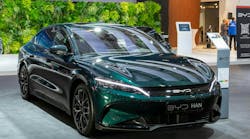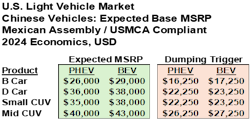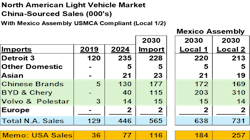We’ve all heard the current political rumblings about Chinese vehicles coming to the United States. The threat of low-cost competition destroying the Detroit 3—and also, perhaps, Tesla and Rivian—is a popular election-season topic this year. So are concerns about customer data collected by the various on-board computing systems and used by foreign entities, including the Chinese government.
Our deeper look into prices, volumes, manufacturing locations and consequences, however, tells a more complex story.
Trade Limits with Unintended Consequences
Today’s protectionist rhetoric is reminiscent of the early 1980s, when Japan agreed to a voluntary export program limiting the number of vehicles that would be imported into the United States. The program was the result of political pressure and potential legislation attempting to protect domestic manufacturers. At the time, domestic manufacturers had 75% of the U.S. market.
The prices of BYD vehicles imported from Mexico would be competitive with sales leaders in the U.S. market. Thus, these imports would not be subject to countervailing duties to counteract dumping.
Dumping thresholds have also been estimated. Chinese prices would have to be below these amounts for the dumping complaint to be considered. For example, there are imported passenger cars that sell in the U.S. for less than $23,000. Likewise, there are small CUVs that sell for less than $24,000. Given Ford’s announced plans for battery-electric vehicles under $30,000, the dumping triggers appear to be reasonable estimates.
2030: BYD & Chery with 150,000 units of Capacity in Mexico (Local 2):
- BYD with USMCA-compliant assembly by 2030 (U.S. imports are duty-free)
- 4 models: 2 cars and 2 CUVs as BEV only.
- 48 state distribution
- Chery with USMCA-compliant assembly by 2030 (U.S. imports are duty free)
- 3 models: 1 car and 2 CUVs with BEV and PHEV.
- 48 state distribution.
- Same duty and USMCA assumptions as the Local 1 scenario.
Sales of Chinese vehicles in the United States under the Local 2 scenario would be 257,000, or 1.5% of the light vehicle market. This would hardly amount to a bloodbath. Chinese-sourced volume in North America would be much higher at 731,000 with most of the sales in Mexico or exported outside the USMCA region.
The 141,000 units of incremental volume generated by seven new BYD and Chery models would conquest 35,000 units of Detroit 3 volume. However, more damage will be inflicted on the Detroit 3 by the 32 additional models launched by existing and new competitors over the same time frame. The lack of passenger models in their portfolio doesn’t help either.
In essence, the third wave of Asian models is only a piece of the changing competitive landscape.
Potential Unintended Consequences
Import duties and trade restrictions are intended to protect domestic production and labor at the expense of consumers. Sometimes the duties are warranted, like when products are being dumped (sold below cost) into a market. Yet, these duties are imposed after the violation is discovered, not before.
It is conceivable that the U.S. could impose 27.5% duties on Chinese imports from Mexico that are USMCA-compliant. However, this would violate USMCA rules as approved by Congress. This policy variant could be implemented under that same rationale that President Trump used early in his administration—but it would be a real stretch.
The requirement to differentiate Chinese models from General Motors and Ford exports would be threading a needle. Potential retaliation would likely come from the Chinese government.
The U.S. could elect to exit USMCA in 2026 and begin to apply significant import duties on all Mexican exports—Detroit 3 and others. Perhaps that is candidate Trump’s intent.
This new policy could help U.S. labor, but the higher product cost would increase prices and dampen demand. This would result in a negative cost increase for the Detroit 3, Nissan, Toyota, Volkswagen and any other manufacturer using Mexico as a manufacturing base to supply U.S. consumption. What would Tesla do with their new Mexican facility?
National Security
Then comes the larger national security argument about Chinese spying through connected vehicles. If it is a chip argument, then all Chinese vehicles in the U.S. would have to be restricted, and this may include chips that the Chinese provide to other manufacturers. The restrictions would include Volvo, Polestar, BYD, Chery and Buick and Lincoln imports.
Be careful what you ask for. If the U.S. needs an enhanced industrial policy that would protect GM, Ford and Stellantis, then it needs to be comprehensive, and transparent to trading partners. It needs to comprehend a rewrite and congressional approval of the USMCA agreement, more local content requirements and joint-venture requirements for investment in the United States.
A ban on Chinese brands due to national security reasons would need to be long-lasting and specific. Automotive suppliers should listen to the rhetoric. More importantly, they should continue to press U.S. trade representatives and political candidates to support any claims with a rational look at the data and assumptions.
Given the size of U.S. auto investment in China, the debate needs to happen at the negotiating table, not on the campaign trail.
Warren Browne is an adjunct professor of economics and trade at Lawrence Technological University.
Sam Fiorani is vice president, global forecasting, AutoForecast Solutions LLC.





